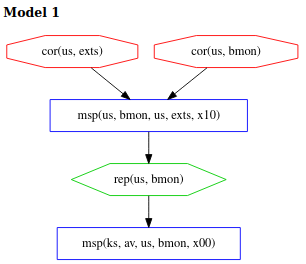Copland
Semantics, languages and tools for layered attestation
- Tampering Paper
- Copland Collection Updated
- CHASE Tutorial Updated
- Maat Released
- CHASE Tutorial Added
- Flexible Mechanisms Paper Published
- Automated Trust Analysis Paper Accepted
- MEMOCODE Paper Accepted
- NFM '21 (Virtual) Conference Presentation
- Copland Collection Released
Publications
Documentation
Software
Blog
Example 1b
*bank: @ks[av us bmon] +~+ @us[bmon us exts]
The 3 models in the last example characterize all the ways for an adversary to corrupt exts and avoid detection by the attestation. In some of these models, the adversary performs actions that we might consider to be difficult to perform. For example, in model 2, the adversary corrupts av and similarly, in model 1, the adversary corrupts bmon after it has been measured. A relying party may have reason to believe that such adversary actions are unlikely. For example, the relying party may trust the kernel level protections will protect av from corruption, or that, say, address space layout randomization makes a successful runtime corruption of bmon extremely unlikely. Alternatively, the relying party may simply be willing to take these assumptions on blind faith. If the attestation is meant to support an interaction that is not overly sensitive, the relying party might believe the adversary is capable of performing one of these actions, but also be willing to take such a risk.
For these reasons, the relying party may wish to view only those models in the Chase output without these possibilities. Any models that remain in the Chase output represent the residual risk beyond the risk the relying party is comfortable with. Chase is run with the following ex1b.gln file with axioms specified to disallow deep and recent corruptions:
[ bound = 500, limit = 5000, input_order ]
% Assume adversary avoids detection at our main measurement
% event. Others can be added.
l(V) = msp(us, M, us, exts, X)
=> corrupt_at(us, exts, V).
% Assumptions about system dependencies.
depends(ks, C, ks, av) => false.
depends(us, C, us, bmon) => false.
depends(us, C, us, exts) => false.
% Axioms defining "deep" components
% We don't want to see models with deep corruptions
l(V) = cor(ks, M) => false.
% Axiom defining which components cannot be recently corrupted
prec(V, V1) & l(V1) = cor(P,C) & ms_evt(V)
=> false.
m4_include(`ex1b.gli')m4_dnl
m4_include(`ex1b_dist.gli')m4_dnl
m4_include(`thy.gli')m4_dnl
The first axiom under the heading for deep corruptions tells Chase to disallow corruptions
of kernel space components. The antecedent (on the left side of the =>) states that for every
event V, where V has the form cor(ks, M), the consequence (on the right side of =>) is false.
This implies to Chase that any corruption event of a component in ks is not possible and should
not be included in the Chase analysis.
The second axiom under the heading for recent corruptions tells Chase to disallow
the corruption of components that happen after a measurement event. The antecedent states that if
event V occurs before event V1 and event V1 is of the form cor(P,C) and event V is a
measurement event, then the consequence is false. This means that Chase cannot consider V1 to be
a corruption event when V is a measurement event and comes before event V1. We must explicitly
tell Chase what components are considered deep and what we mean by recent events.
Analysis
As we see below, model 1 and 2 from ex1 are no longer found by Chase since model 1 contained
a recent corruption and model 2 contained a deep corruption. Therefore we see that model 1
in this example was model 3 from the last example. The corruptions of bmon and exts are
not considered deep or recent, so this adversary behavior is still permitted under the
additional constraints and the adversary still has one scenario for avoiding detection at exts.

Click here to move on to the next example.